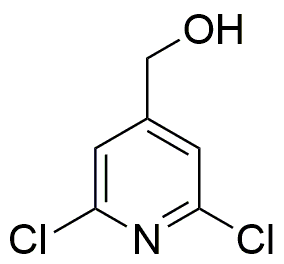2,6-Dichloro-4-pyridinemethanol is widely utilized in research focused on:
- Pharmaceutical Development: This compound serves as an important intermediate in the synthesis of various pharmaceuticals, particularly those targeting neurological disorders, due to its ability to interact with specific receptors in the brain.
- Agricultural Chemicals: It is used in the formulation of herbicides and pesticides, providing effective control over unwanted plant growth while minimizing harm to beneficial organisms.
- Analytical Chemistry: The compound is employed as a reagent in analytical methods, aiding in the detection and quantification of other substances in complex mixtures, which is crucial for quality control in manufacturing.
- Material Science: It is incorporated into the development of specialized coatings and polymers, enhancing properties like durability and resistance to environmental factors.
- Biochemical Research: Researchers utilize this compound in studies related to enzyme inhibition and metabolic pathways, providing insights into cellular processes and potential therapeutic targets.
General Information
Properties
Safety and Regulations
Applications
2,6-Dichloro-4-pyridinemethanol is widely utilized in research focused on:
- Pharmaceutical Development: This compound serves as an important intermediate in the synthesis of various pharmaceuticals, particularly those targeting neurological disorders, due to its ability to interact with specific receptors in the brain.
- Agricultural Chemicals: It is used in the formulation of herbicides and pesticides, providing effective control over unwanted plant growth while minimizing harm to beneficial organisms.
- Analytical Chemistry: The compound is employed as a reagent in analytical methods, aiding in the detection and quantification of other substances in complex mixtures, which is crucial for quality control in manufacturing.
- Material Science: It is incorporated into the development of specialized coatings and polymers, enhancing properties like durability and resistance to environmental factors.
- Biochemical Research: Researchers utilize this compound in studies related to enzyme inhibition and metabolic pathways, providing insights into cellular processes and potential therapeutic targets.
Documents
Safety Data Sheets (SDS)
The SDS provides comprehensive safety information on handling, storage, and disposal of the product.
Product Specification (PS)
The PS provides a comprehensive breakdown of the product’s properties, including chemical composition, physical state, purity, and storage requirements. It also details acceptable quality ranges and the product's intended applications.
Certificates of Analysis (COA)
Search for Certificates of Analysis (COA) by entering the products Lot Number. Lot and Batch Numbers can be found on a product’s label following the words ‘Lot’ or ‘Batch’.
Numéro de catalogue
Numéro de lot/série
Certificates Of Origin (COO)
This COO confirms the country where the product was manufactured, and also details the materials and components used in it and whether it is derived from natural, synthetic, or other specific sources. This certificate may be required for customs, trade, and regulatory compliance.
Numéro de catalogue
Numéro de lot/série
Safety Data Sheets (SDS)
The SDS provides comprehensive safety information on handling, storage, and disposal of the product.
DownloadProduct Specification (PS)
The PS provides a comprehensive breakdown of the product’s properties, including chemical composition, physical state, purity, and storage requirements. It also details acceptable quality ranges and the product's intended applications.
DownloadCertificates of Analysis (COA)
Search for Certificates of Analysis (COA) by entering the products Lot Number. Lot and Batch Numbers can be found on a product’s label following the words ‘Lot’ or ‘Batch’.
Numéro de catalogue
Numéro de lot/série
Certificates Of Origin (COO)
This COO confirms the country where the product was manufactured, and also details the materials and components used in it and whether it is derived from natural, synthetic, or other specific sources. This certificate may be required for customs, trade, and regulatory compliance.


